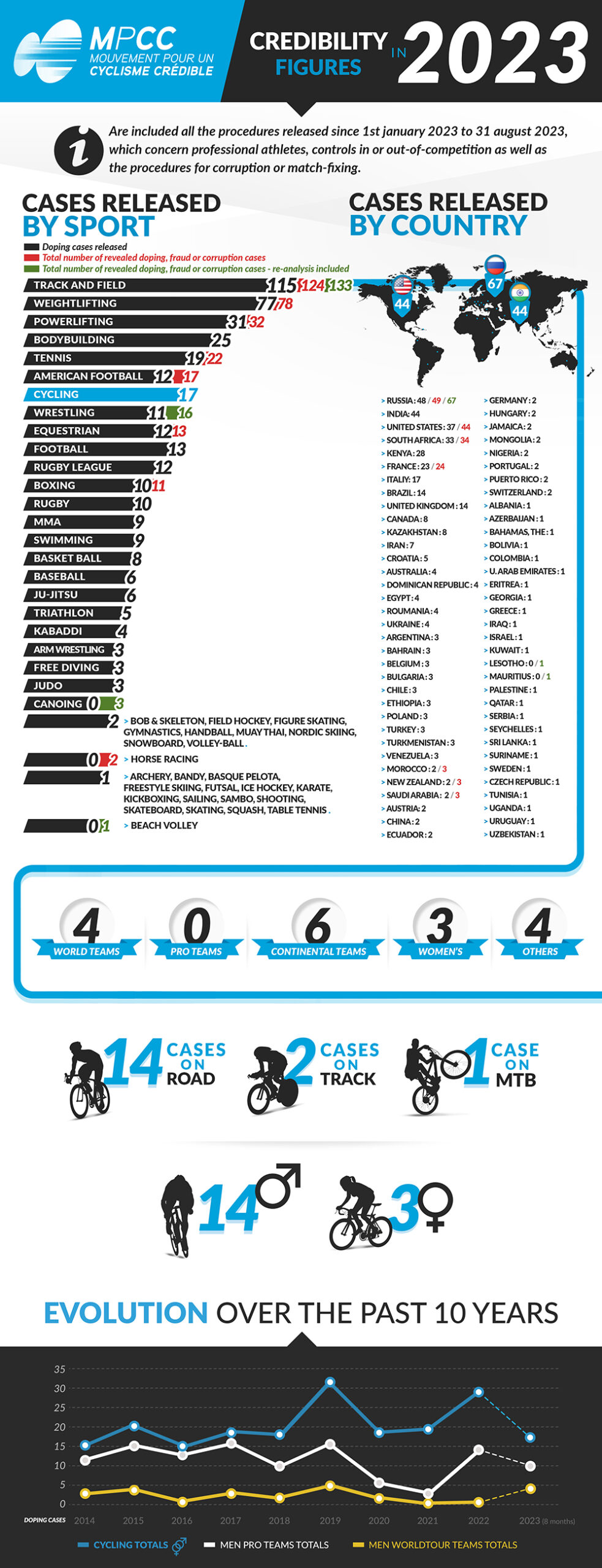For the second publication, this year, of the “Credibility Figures”, the MPCC took notice of the fifteen or so additional cases that have tainted professional cycling over the last four months. These revelations are a reminder of the extent to which the fight against doping must remain a constant in our sport.
Between May 1 and August 31, we identified almost 200 cases of suspected doping in sport, at national or international level, revealed by national agencies, federations or press articles. Athletics remains at the top of the list with almost a quarter of the cases. But this does not mean that this sport remains the “poor relation” in the fight against doping. The independent organisation Athletics Integrity Unit (AIU) has been producing considerable work since it was founded in April 2017 to encourage athletes to play by the rules and deter cheats.
On a national scale, the large number of doping cases involving South African athletes in the last four months can be explained by greater transparency on part of SAIDS, the South African anti-doping agency, about the offences committed. This transparency remains the key to restoring the credibility of top-level sport.
In this respect, the MPCC took notice of fourteen new cases of alleged doping involving professional cyclists and support staff since April. Aggravating circumstance : four of them involved World Tour riders: Alex Baudin, Robert Stannard, Miguel Angel Lopez and Michel Hessmann. This is the first time in four years that so many cases involving riders from the world’s elite level have come to light in such a short space of time. In 2019, there were five cases at this level (four of which were uncovered by the Aderlass police operation).
But looking in detail at the four cases that have come to light in recent months, we can see that two of them no longer belong to the same team since the test that triggered their disciplinary procedure. Miguel Angel Lopez was riding for a Continental team this season. The period incriminating the Colombian climber dates back to the building up to the 2022 Giro d’Italia, during his last year of competition with the World team Astana. As for Robert Stannard, the rider from Alpecin-Deceuninck (MPCC member) was notified by the UCI of the “use of prohibited methods and/or substances” during the 2018 and 2019 seasons. At the time, the Australian was riding for a World Team that was not an MPCC member : Mitchelton-Scott.
On July 31, Frenchman Axel Baudin has been given a precautionary suspension by his team AG2R-Citroën team, following the presence of tramadol detected during a test at the last Giro. His team, a founding member of the MPCC, thus applied one of the fundamental rules of our movement: withdrawing a rider from competitions as soon as a positive test is reported. Two weeks later, the German Michel Hessmann was also suspended by his team (Jumbo-Visma), following a positive out-of-competition test on 14 June by his country’s national anti-doping agency (NADA).
Pending the outcome of the procedures, it would be hasty to draw conclusions about the World Tour on the basis of these latest revelations. But far from the recent rumours and suspicions, this significant increase in cases at the highest level of competition in 2023 is irrefutable (only one in 2022, none in 2021, two in 2020) and calls the MPCC to question. The riders’ health and the credibility of professional cycling are at stake. These revelations are a reminder of the soundness of the approach taken by our association, which is constantly committed to fairness and ethics in our sport. They also underline the responsibility of riders, managers and team staff to play their part in the fight against doping. In this respect, we salute the sixteen women’s teams that have already joined us over the last decade. The growing popularity of the UCI women’s circuit is very good news for cycling, but it must also go along with safeguards such as the MPCC. Finally, we encourage non-member professional teams and their riders to join us.

